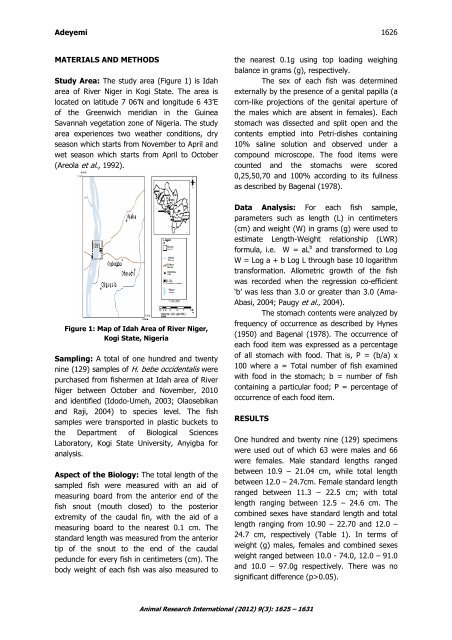3. ADEYEMI.pdf - Zoo-unn.org
3. ADEYEMI.pdf - Zoo-unn.org
3. ADEYEMI.pdf - Zoo-unn.org
Create successful ePaper yourself
Turn your PDF publications into a flip-book with our unique Google optimized e-Paper software.
Adeyemi<br />
1626<br />
MATERIALS AND METHODS<br />
Study Area: The study area (Figure 1) is Idah<br />
area of River Niger in Kogi State. The area is<br />
located on latitude 7 06’N and longitude 6 43’E<br />
of the Greenwich meridian in the Guinea<br />
Savannah vegetation zone of Nigeria. The study<br />
area experiences two weather conditions, dry<br />
season which starts from November to April and<br />
wet season which starts from April to October<br />
(Areola et al., 1992).<br />
the nearest 0.1g using top loading weighing<br />
balance in grams (g), respectively.<br />
The sex of each fish was determined<br />
externally by the presence of a genital papilla (a<br />
corn-like projections of the genital aperture of<br />
the males which are absent in females). Each<br />
stomach was dissected and split open and the<br />
contents emptied into Petri-dishes containing<br />
10% saline solution and observed under a<br />
compound microscope. The food items were<br />
counted and the stomachs were scored<br />
0,25,50,70 and 100% according to its fullness<br />
as described by Bagenal (1978).<br />
Figure 1: Map of Idah Area of River Niger,<br />
Kogi State, Nigeria<br />
Sampling: A total of one hundred and twenty<br />
nine (129) samples of H. bebe occidentalis were<br />
purchased from fishermen at Idah area of River<br />
Niger between October and November, 2010<br />
and identified (Idodo-Umeh, 2003; Olaosebikan<br />
and Raji, 2004) to species level. The fish<br />
samples were transported in plastic buckets to<br />
the Department of Biological Sciences<br />
Laboratory, Kogi State University, Anyigba for<br />
analysis.<br />
Aspect of the Biology: The total length of the<br />
sampled fish were measured with an aid of<br />
measuring board from the anterior end of the<br />
fish snout (mouth closed) to the posterior<br />
extremity of the caudal fin, with the aid of a<br />
measuring board to the nearest 0.1 cm. The<br />
standard length was measured from the anterior<br />
tip of the snout to the end of the caudal<br />
peduncle for every fish in centimeters (cm). The<br />
body weight of each fish was also measured to<br />
Data Analysis: For each fish sample,<br />
parameters such as length (L) in centimeters<br />
(cm) and weight (W) in grams (g) were used to<br />
estimate Length-Weight relationship (LWR)<br />
formula, i.e. W = aL b and transformed to Log<br />
W = Log a + b Log L through base 10 logarithm<br />
transformation. Allometric growth of the fish<br />
was recorded when the regression co-efficient<br />
‘b’ was less than <strong>3.</strong>0 or greater than <strong>3.</strong>0 (Ama-<br />
Abasi, 2004; Paugy et al., 2004).<br />
The stomach contents were analyzed by<br />
frequency of occurrence as described by Hynes<br />
(1950) and Bagenal (1978). The occurrence of<br />
each food item was expressed as a percentage<br />
of all stomach with food. That is, P = (b/a) x<br />
100 where a = Total number of fish examined<br />
with food in the stomach; b = number of fish<br />
containing a particular food; P = percentage of<br />
occurrence of each food item.<br />
RESULTS<br />
One hundred and twenty nine (129) specimens<br />
were used out of which 63 were males and 66<br />
were females. Male standard lengths ranged<br />
between 10.9 – 21.04 cm, while total length<br />
between 12.0 – 24.7cm. Female standard length<br />
ranged between 11.3 – 22.5 cm; with total<br />
length ranging between 12.5 – 24.6 cm. The<br />
combined sexes have standard length and total<br />
length ranging from 10.90 – 22.70 and 12.0 –<br />
24.7 cm, respectively (Table 1). In terms of<br />
weight (g) males, females and combined sexes<br />
weight ranged between 10.0 - 74.0, 12.0 – 91.0<br />
and 10.0 – 97.0g respectively. There was no<br />
significant difference (p>0.05).<br />
Animal Research International (2012) 9(3): 1625 – 1631

















